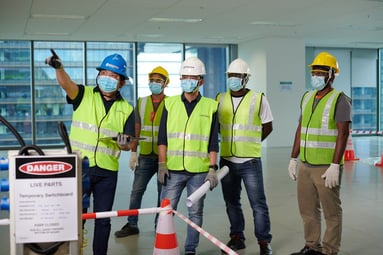Making the best of our remote working reality

How can businesses create a shared sense of purpose and maintain a happy, healthy workforce at a time when everyone has been told to keep to themselves? We’ve put together a five-step guide to support businesses to uphold culture and maintain productivity as we overcome the current social constraints and shift to remote-only operating practices.
The past few weeks have led us all into unchartered territory. Businesses around the world are fundamentally disrupting their ongoing day-to-day operations due to COVID-19 as they seek to comply with stringent local market regulations around travel, social distancing, city lockdowns and working from home. The consequence is that the volume of our population now working from home is unprecedented.
The unintended upside of this new reality is that the practice of remote working and making it as effective as possible for our people and businesses is now under fast-track development.
In truth, many organisations today are adept at extending the four walls of their business into the virtual domain to account for growing numbers of remote workers. However, precious few of them operate 100% remote working as standard. We all are having to learn about this new landscape together, bereft of any time for transition and adaptation.
One of the biggest problems we’re anticipating over the coming weeks is that, while businesses focus relentlessly on solving logistical challenges and maintaining productivity, they inadvertently overlook the social and community implications of remote working at scale, and the resultant impact on their workforce, should the situation continue for longer than anticipated.
At Unispace, we like to talk about ‘the power of places’ – the role that the physical workplace has in creating social connectivity and alignment around an organisational vision. We know that virtuality can never fully replace actuality; this runs counter to human instinct. We are just not wired to actively try and avoid our fellow peers. So, what are some of the ways we can support our people to optimise their home working processes, maintain that sense of sociability and look after their mental health?
1. Maintaining a good balance between work 'modes'
When it’s business-as-usual, teams and individuals within the physical workplace tend to exist in a variety of different work modes, broadly classified as:
- Individual and routine work mode (open to distraction)
- Focused work mode (not open to distraction)
- Socialising and collaboration mode
- Learning mode
Our data suggests that the most productive, happy and engaged workforces enjoy a healthy balance of all four modes over the course of their work day. However, in a remote-only environment, focused work and learning may be over-emphasised, individual work will look fundamentally different (no colleagues around, and a different set of distractions), and socialising can be overlooked entirely.
The lack of the latter two modes could have a negative impact on overall productivity, so it’s important that businesses take action to try and enable work-related distractions, socialisation and collaboration opportunities within their virtual environments. At Unispace we’ve looked to solve this challenge by creating specific chat rooms and forums for a wide range of different groups, topics and work areas. Productivity tools such as Slack or Microsoft Teams can also be used to fill the void, or even Skype, Facebook or WhatsApp, enabling staff to continue shifting between work modes as they go through each working day.
2. Make time for non-work connectivity
People are used to co-existing in close proximity to their colleagues, many of whom are also their friends. Remote working has the potential to cut off individual and collective downtime, making everyone 100% work-focused without any attention given to the in-between work moments that help people relax, take a break and re-energise.
Businesses should consider allocating dedicated 30-minute slots for non-work socialising; a ‘virtual teatime’, where everyone makes a hot drink and dials into a video conference to connect with one another, catch up and share stories.
For organisations based across multiple territories, COVID-19 actually has the potential to forge new connections between staff, providing they can access one another. Everyone has a common purpose and discussion topic right now, so take appropriate measures to allow teams to come together despite their physical separation.
3. Replicate existing structures wherever you can
When Ernest Hemingway was at the height of his literary powers, legend has it that the author used to put his hat and coat on each morning, go for a short walk around his building and then officially enter the workplace for the day.
While Hemingway was of course returning to the exact same building he’d left moments earlier, he understood the value of creating separation between the personal and professional. Most home workers need to find ways of provoking this mindset shift, otherwise they risk the total blurring of work/life boundaries, to the detriment of overall wellbeing.
One way businesses can help is by maintaining the structure of the typical working day. This starts with encouraging staff to stick to the usual working hours. If they’re struggling, it could be necessary to implement team or company-wide emails or calls at the start and finish of each day to create a clearer point of separation between work and home life.
Similarly, if there are normally weekly company meetings every Monday morning at 9.30am, businesses should make sure these stay in the diary and are carried out remotely. The same is true of regular client calls or meetings. Don’t abandon ongoing line management processes or training programmes – instead, organisations should look for effective ways to carry these out online or over the phone too.
4. Don't lose sight of physical health and safety
In the age of laptops, Wi-Fi and smartphones, it’s certainly easier than ever before for individuals to work remotely. But that doesn’t mean it’s easy.
Many people don’t have private home offices and studios; they have no room for large desks and ergonomically-designed office chairs. Others will be sharing their working environments with partners, housemates or even children.
In our experience, businesses are often very quick to identify technical barriers to home working (e.g. difficulty connecting to centralised computer systems and software), but sometimes forget to consider individuals’ physical health and safety. Instead, they need to audit their staff to determine what each person’s current home setup is, whether it’s safe and appropriate for daily usage and, if it isn’t, what do they need to bring the setup up to scratch.
The solution is going to look different for each organisation based on the nature of their work and the typical profile of their employees. Not every business will be able to commit additional spending at this difficult time, but maintaining basic physical health and safety has to remain a priority – it’ll be the employer that suffers as and when a team member sustains an injury.
Finally, maintaining health and safety also means making sure that staff are not glued to their desks, take regular breaks and are stimulated to do some exercise. And, in the event that people are feeling unwell, they need to be encouraged to take time off – particularly given that it’s harder to distinguish work/life balance when people are already working from home.
5. Keeping teams mentally healthy requires a lot of proactivity
Alongside physical wellbeing, organisations need to find ways to audit the mental health of their workers. Again, there’s a big risk that businesses will overlook this aspect of 100% home working as they strive to connect the logistical dots and keep the lights on.
Remember that many employees have never worked full-time at home before, particularly younger employees that are used to a mentor-based, social working environment. Some team members will flag their concerns if they’re struggling; others, such as social introverts, may not, even though they’re actually highly reliant on social interaction.
This is an issue that everyone – from leadership to the most junior levels of the organisation – could struggle with. All employees need to keep an eye out to see how their peers, colleagues and friends are doing. Managers need to play an especially proactive role, maintaining regular contact with their teams to see how they’re feeling and – if necessary – receiving bespoke mental health training to make them better equipped to have these conversations whenever necessary.
If you would like support in mapping out home working processes, please get in touch and we’ll be happy to give you further pointers and advice on how you can best support your teams.



